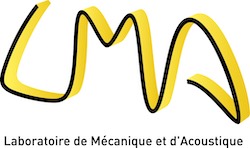Jury
- DALMONT, Jean-Pierre, Université du Maine, Rapporteur
- SHARP, David, Open University, Rapporteur
- CHABASSIER, Juliette, INRIA, Examinateur
- HELIE, Thomas, IRCAM, Examinateur
- POCHEAU, Alain, Aix-Marseille Université, Examinateur, Président du jury
- GUILLEMAIN, Philippe, CNRS, LMA, Directeur de thèse
- KERGOMARD, Jean, CNRS, LMA, Invité
- JOUSSERAND, Michael, Buffet Crampon, Invité
Abstract
The research goal of this dissertation is to evaluate how the tonehole lattice cutoff frequency affects the sound production and radiation of woodwind instruments. Below the cutoff, waves entering the tonehole lattice are evanescent, where as above cutoff waves can propagate freely within the lattice. Therefore, the low frequency response of the resonator that determines the playing frequency of a woodwind is set by the length between the reed and the first open tonehole, while the high frequency response is governed by the remaining open toneholes downstream on the instrument. A study of the cutoff frequency that separates these two bands is, in effect, a study of how this ’unused’ portion of the tonehole lattice may influence the sound of the instrument. Following the work of Benade in the 1960s, studies on this subject have been rare, despite its central importance to the sound of woodwind instruments. This dissertation includes analytical, numerical, and experimental advances on the subject of the cutoff frequency, approached in three published studies. In the first, cylindrical academic resonators are analytically designed to have specific cutoffs while maintaining the same first resonance frequency. They are then compared using digital synthesis based on a physical model of the instrument. The cutoff is found to have a modest impact on sound production, evaluated using the pressure and flow waveforms within the mouthpiece, where the greatest effect is a randomization of the relative amplitude of even and odd harmonics above the cutoff. There is little evidence that the `ease of playing’ of the resonators is affected by the cutoff. In the second study, the academic resonators are played by a musician using a clarinet mouthpiece during/ //in situ/ measurements. The radiated sound demonstrates a `region of reinforced spectra,’ for which there is an amplitude increase of both even and odd harmonics around the cutoff of each resonator. The third study derives the cutoff theory for conical resonators and introduces new quantitative descriptors to estimate the cutoff of acoustically irregular lattices. An analysis of the saxophone demonstrates that the cutoff varies considerably over the first register of the instrument. The results also demonstrate ways in which the theory of wave propagation in periodic media can succeed or fail when applied to real instruments. Preliminary results for two additional studies are presented. In the first, the methods developed for the saxophone are applied to another conical instrument, the bassoon. The results show that, compared with the saxophone, the cutoff of the bassoon is homogeneous across different fingerings of the first register. In the second, the effect of diffraction from a simplified resonator is evaluated using a boundary element method. The results are compared with a simplified analytical radiation model and anechoic measurements, showing that the more efficient simple model is generally sufficient. This dissertation demonstrates ways in which the cutoff affects both internal waveforms and, more importantly, the radiated soundfield of woodwind-type instruments. It also advances the theoretical basis for incorporating the cutoff into a tonehole lattice conception, which is of practical use for instrument manufacturers.


